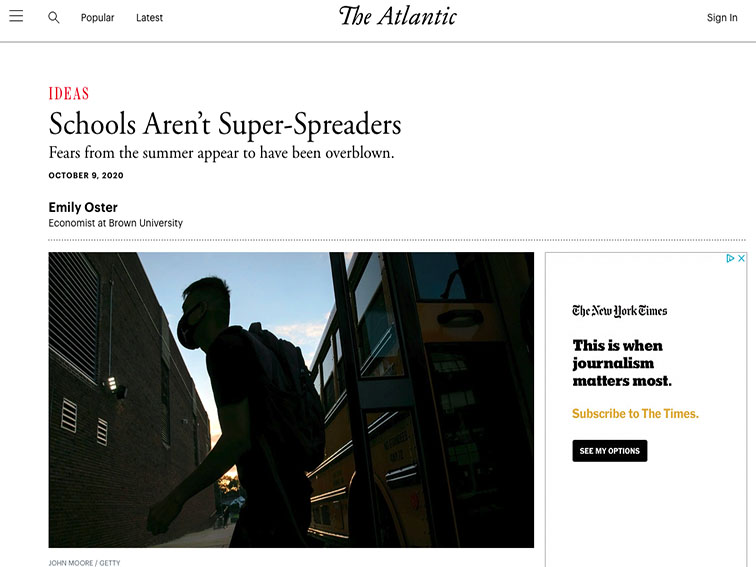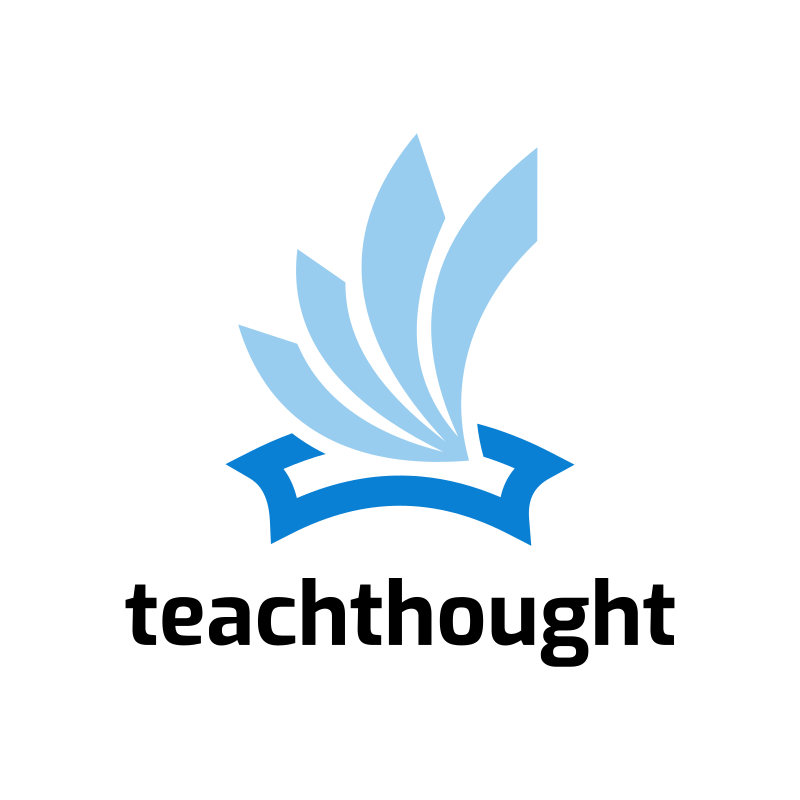
The ‘Schools Aren’t Superspreaders’ Argument Misses A Lot About COVID
contributed by Sean McCauley
A popular Atlantic article on early data seems to show schools can safely reopen, but worrisome questions remain.
Econ. Prof. Emily Oster of Brown U. published an Oct. 9 Atlantic article, “Schools aren’t Super-Spreaders: Fears from the summer appear to have been overblown.” Prof. Oster is an expert number cruncher and enthusiastic advocate of fact-based reasoning, as may be inferred from her Twitter feed and books, “Expecting Better” and “Cribsheet: A Data-Driven Guide to Better, More Relaxed Parenting, from Birth to Preschool (The ParentData Series).” Both aim to help parents make informed decisions regarding the health and well-being of their children based on statistics from authoritative sources.
Oster told Time in April 2019, “One of my least favorite phrases is ‘studies say’ because you can always find a study that says whatever is the thing that you think already. And one of the things I try to do here is not what does a study say but what do all the studies say.”
This is precisely what one would expect from a respected researcher from a top-shelf school like Brown, but Oster’s “more direct than typical” article flatly denying school openings cause super-spreader events flies in the face of that precept. It does so in spite of new reports from the CDC noting that 90% of Americans live in counties falling into the two highest risk categories for reopening schools, and the American Academy of Pediatrics showing a rapid rise in pediatric COVID-19 cases over the last five months, not to mention an alarming 14% increase in children with COVID from Sept. 17 to Oct. 1 as schools begin to reopen.
The questionable exclusion of these studies becomes less surprising with a brief glance at Prof. Oster’s previous Atlantic articles. Oster questions distance learning and school closures from almost the beginning, publishing articles such as “Parents Can’t Wait Around Forever” July 2, and “The ‘Just Stay Home’ Message Will Backfire” May 14, just eight weeks after her home state of Rhode Island closed in-person education and entertainment venues.
Both articles also appear in Atlantic, which makes sense as her new “Schools Aren’t Super-Spreaders” article currently ranks as the publication’s no.1 most popular piece.
However, while Oster’s fresh arguments come directly from authoritative data, they’re also startlingly brash conclusions in light of where the numbers come from, how many of them there are, and the disease’s plainly fatal potential.
Oster’s case-closing Atlantic article cites “data on almost 200,000 kids in 47 states from the last two weeks of September” which showed “an infection rate of 0.13 percent among students and 0.24 percent among staff.” That works out to about “1.3 infections over two weeks in a school of 1,000 kids,” and “2.2 infections over two weeks in a group of 1,000 staff.” She notes that “Even in high-risk areas of the country, the student rates were well under half a percent” and invites readers to “see all the data here.”
Schools Aren’t Superspreaders If You Leave Out the Teachers
Here’s the thing, though: while the data may be viewed on an online dashboard programmed by stats-software company Qualtrics under direction from Oster, it actually comes from “a group of educators from superintendents’ and principals’ associations who had access to schools.” In other words, it comes from administration officials from the principal upward, all of whom have every reason to want schools open ASAP.
President Trump has directly threatened the funding of schools operating under distance learning, saying relief funds will be conditionally available to physically open sites, putting further pressure on administrators already squeezed by dire budget constraints. This pressure comes from parents, too, whom the NY Times dubs “involuntary homeschoolers” of “students falling months behind.” These parents proudly sue their state governors for closing schools during the epidemic and hit the streets to protest closures even as COVID spikes in their areas.
That data would be better informed by including numbers from other sources such as teachers’ unions and associations, as evidenced by cases reported to newspapers by teachers in COVID-fraught districts where testing isn’t mandatory. This is the case with the New York City Department of Education, where parents might never have known about faculty infections except that teachers tested themselves and informed their union, who then went to journalists without involving admin officials.
There’s also a tracker run by the Natl. Education Assoc. created by a Kansas teacher which NPR reported on at the end of August. A simple run through just the first ten states alphabetically, Alabama through Georgia, tells a much different story than Oster’s dashboard. According to the NEA tracker as many as 21-41% report infected faculty in some states (GA, CT, AL, FL). In fact, of those ten states, districts saw an average infection rate of 19%, much higher than one would suspect with an infection rate of just a fifth of a percentage point.
Naturally, these amounts measure different things — the percentage of infected people vs. the percentage of infected districts. Even so, this rudimentary research shows a massive disparity between Oster’s sample and that provided by teachers, one which makes plenty of sense considering 45% of all UK cases stem from education settings according to Public Health England as reported by WSWS Oct 4. That’s even more bleak considering the US ranks as the global leader in infections while the UK comes in 12th.
Incomplete Data Around COVID Continues To Be A Problem
Note, too, that while private schools haven’t been included in the above numbers because they don’t belong to public districts, they are included in the NEA’s tracker. This brings us to the next issue with Oster’s claim, her admittedly lacking sample from private schools. She writes of this:
“Private schools have little or no reporting requirements for coronavirus, but in many locations they are the only ones to open. These private schools are an opportunity to learn about what might happen when public schools open in these areas, but only if we have data.”
OK, but how much of the picture are we missing, then? Of Oster’s collected numbers, she cites a population of “400,000 children in more than 700 schools across 48 states, while the total K-12 population in the United States is about 56 million.” She says frankly of this, “So we have a way to go. About 123,000 of those children are in person on an average day, along with 47,000 staff members.”
This amounts to a startlingly modest 1/140th of students in the US and apparently excludes the bulk of private schools. Those schools account for a whopping 25% of all US sites, 68% of which are religious institutions, the spiritual affiliations of which wouldn’t matter if churches weren’t constantly proving themselves undeserving of faith in their ability to keep COVID under control.
Prof. Oster downplays the importance of including these schools in her data, saying, “Private schools … have lower infection rates, which seems to reflect, at least in part, their demographics and the fact that they do more mitigation.” And while it’s certainly true that COVID inordinately affects the poor, private students clearly need representation if her data is to represent the population.
Those students need representation much more than, say, schools with zero infections. Clean schools don’t tell us whether in-person education is a super-spreader event. They just water down the infection rate among all school-going persons. Nevertheless, 100% COVID-free schools are clearly included in her data.
Even if the data were as round as one might prefer, Oster’s project further entices administrators to take part by an understandable but potentially harmful non-disclosure promise that “identifying information on districts or schools will not be made public,” thus ensuring that parents of students in an infected school won’t learn about it from the Qualtrics dashboard.
Not to mention, Oster’s project is ‘largely volunteer,’ which means the moment the data show something contrary to one’s druthers, such a volunteer can up and quit, all but assuring that the hypothesis apparent in week six of data collection will remain supported by that data in week 18.
Making Better Decisions About School Openings And COVID
This seeming bias at the outset is hinted at by tweets from Oster such as her Oct. 8 “framework for making better decisions during the pandemic”:
1. Frame the question
2. Mitigate risk
3. Evaluate risk
4. Evaluate benefits
5. Decide
…which does a great job of not-so-subtly implying the benefits of opening schools outweigh the risks; as well as one-offs about students lucky enough to have in-person school, a passionate lamentation about students impacted by distance learning, and gifts from working moms grateful for her work on “school/daycare” data, all in the space of the last two weeks.
Still, Prof. Oster’s reputation is solid, her tireless enthusiasm for objective analysis verifiable all over the internet. And it’d be a silly mistake to say her ongoing project is without merit when she can produce such findings as “the relative frequency of coronavirus prevention policies (masks are the most common, while routine staff testing is very uncommon)” and “limiting group sizes to under 25 seems to be the mitigation practice that is linked most strongly with low infection rates.”
So while Oster’s assertion seems founded on hubris in early fall 2020, the careful skeptic shouldn’t be surprised if she comes to admit more comprehensive evidence trumps her premature claim in the end, if indeed that’s how it shakes out.
-S. McCauley
Sean K. McCauley is a freelance writer and public-school English teacher in So. Cal., as well as Sr. Editor at Octiive Music Distribution and the author of the Agnostic Bible.
